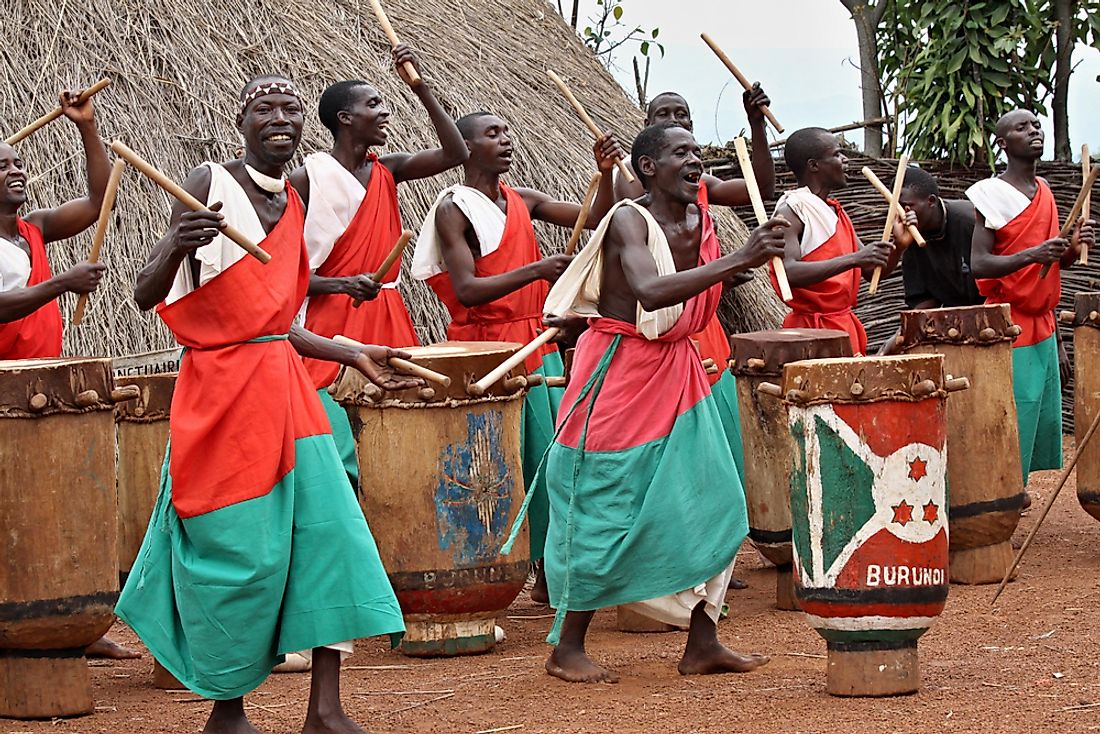The Culture Of Burundi

The landlocked country of Burundi is located in East Africa’s Great Lakes region. It hosts a population of around 11 million individuals.
6. Ethnic Diversity, Language, And Religion
The Hutu is the largest ethnic community of Burundi. The Hutus account for 85% of the country’s population. The Tutsi is the largest ethnic minority community comprising 14% of the total population. Kirundi, French, and English are the official languages of Burundi. The vast majority of Burundians are Christians. Catholic Christians comprise 62.1% of the country’s population. Protestant Christians represent 23.9% of the population.
5. Cuisine Of Burundi
Beans are a staple of the Burundian cuisine. Other staples are sweet potatoes, plantains, peas, cassava, maize, cereals, and exotic fruits. Agricultural fields occupy 80% of the country’s area. Crop cultivation is the primary occupation of most Burundians. Animal breeding is a secondary occupation. Hence, the consumption of meat is low in the country. Cows are regarded as sacred by the people of Burundi. Goat and sheep meat are, however, consumed. Profiteroles, a French filled pastry, is a popular snack in Burundi. Burundians prefer homemade food cooked in vessels made at home.
4. Literature And The Arts
Burundi has a rich heritage of oral literature which features stories, legends, poems, songs, riddles, etc. However, due to the high levels of illiteracy and poverty prevailing throughout the nation, written literary works are virtually nonexistent. Storytelling is an important cultural practice of the Burundians. Children are often trained at the art by the community. Many Burundian stories revolve around cattle that is held sacred by the people.
The Burundians are also trained in various crafts that for both decorative and functional purposes. Baskets woven by Tutsi woven are well-praised. Banana leaves, bast fiber, and papyrus root are used to weave such baskets. Mud dyes are used to decorate them. Ironwork and leather goods are also produced by Burundian craftsmen. Hunting instruments like spears are made by the blacksmiths. The pottery work of the Twa people is also quite famous.
3. Performance Arts
Burundi has a unique and ancient musical heritage. Imvyino songs (songs with a strong beat and short refrain) are sung during family gatherings. The indrimbo song, a subdued form of the imvyino, is sung solo or by a small group. Burundian men sing the kwishongora (rhythmic songs with trills and shouts) while the women sing the bilito (softer and sentimental songs). Another unique form of Burundian music is the whispered singing where songs are usually sung in a low voice so that the music produced by the traditional instruments is heard more clearly. Some of these instruments include the idono (one-stringed fiddle), drums, inanga (stringed instrument involving a hollow wooden bowl), etc. Like music, the Burundians also have their unique folk dances which enrich the culture of the country.
2. Sports In Burundi
Football, basketball, athletics, etc., are some of the sports that are played in Burundi. Football is Burundi's most popular sport and is played both professionally and informally in the villages and towns throughout the country. Burundi even has its own national football team. The team has played quite well in several international football championships in the past. However, the civil war in the country adversely affected the team. Mohammed Tchité is regarded as Burundi’s best footballer.
1. Life and Society
The gender roles in the Burundian society are well-defined. Women are expected to manage the household duties and engage in childcare. Women in rural areas also share the agricultural duties with men. Burundian women are highly underrepresented in business, politics, management, etc. Few hold jobs outside of their homes. The households are usually male-dominated. Men are considered the primary breadwinners. Their decisions on most matters concerning the family and household are considered final.
Many marriages are still arranged. Polygamous relationships are common despite the practice of polygamy being forbidden by civil law and the Christian churches. Often, the father of the groom selects his first wife. Brideprice is paid to the bride’s family in exchange for their daughter. Previously, the brideprice was in the form of livestock but today cash, clothing, etc., are also given.
Burundians, especially those in villages, live as extended families. Usually, small houses hosting single families each are grouped together so that all members of the extended family can live close to each other. Inheritance is patrilineal in nature and generally passes from father to the eldest son.
Childbirth generally takes place at home in the presence of midwives. Children are then introduced to the extended family members after six days in a special ceremony. A naming ceremony is also held where the paternal grandfather names the newborn.
Burundi has a very low literacy rate. The children often drop out of schools at an early age. They are, however, taught the social values by their community members. Male children are given training in traditional dances, military skills, storytelling, and agricultural work. Female children are trained to manage the household chores and handle children, often their younger siblings.
Burundians greet each other by shaking hands and often continue holding hands for several minutes after starting a conversation. Figurative or literal references to cattle is an important part of the greetings. For example, both parties might wish each other large cattle herds, a sign of prosperity. Elders are highly respected in Burundian society. They are considered wise and experienced and their advice is highly valued.











